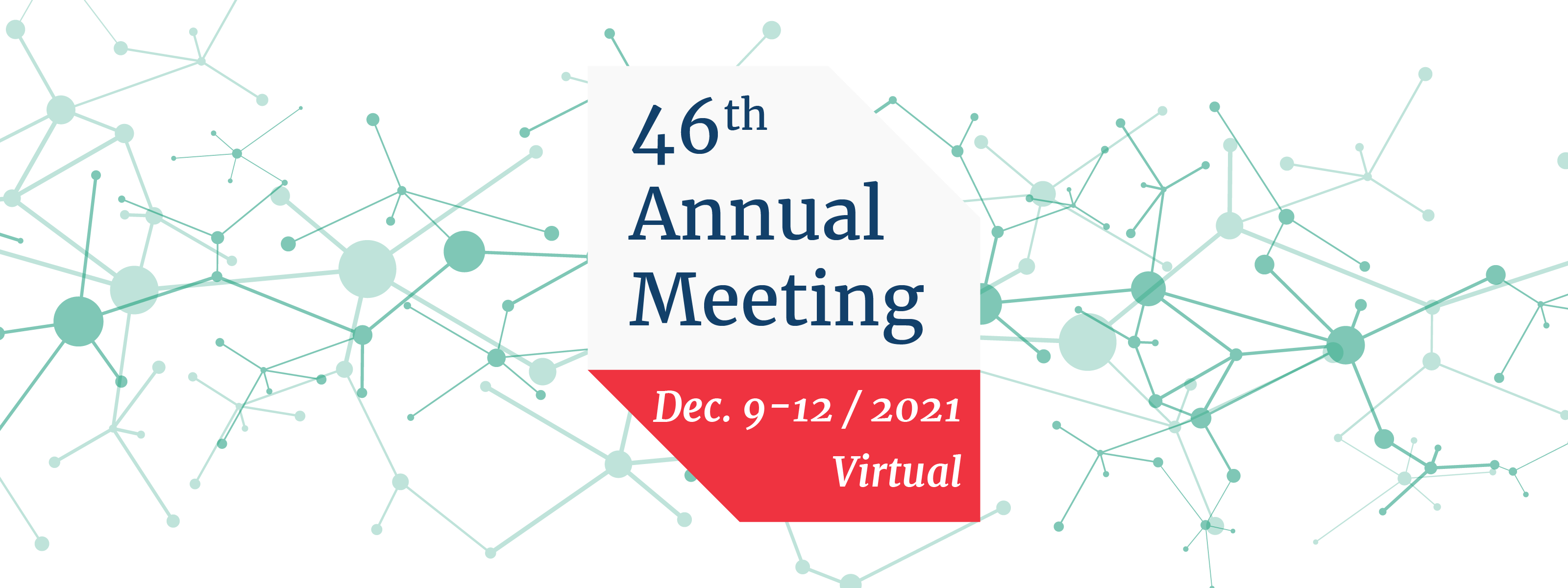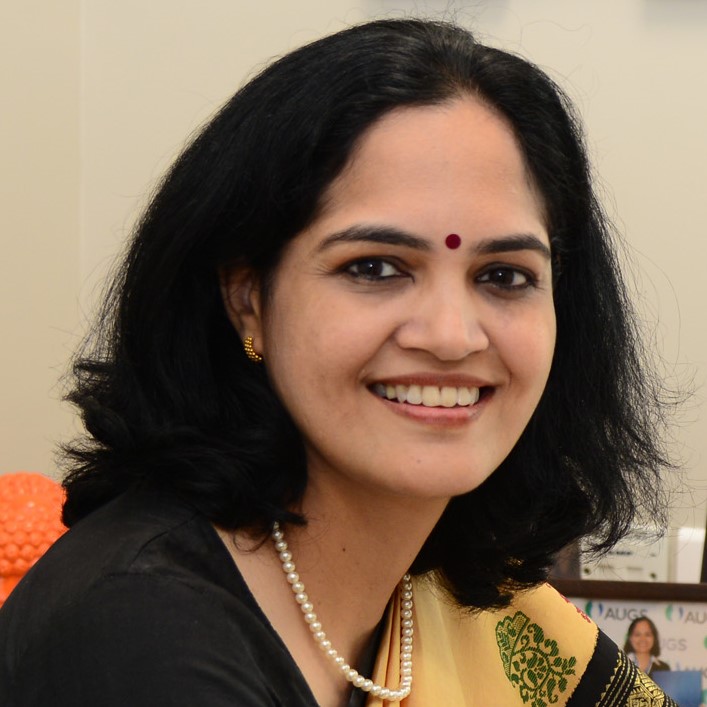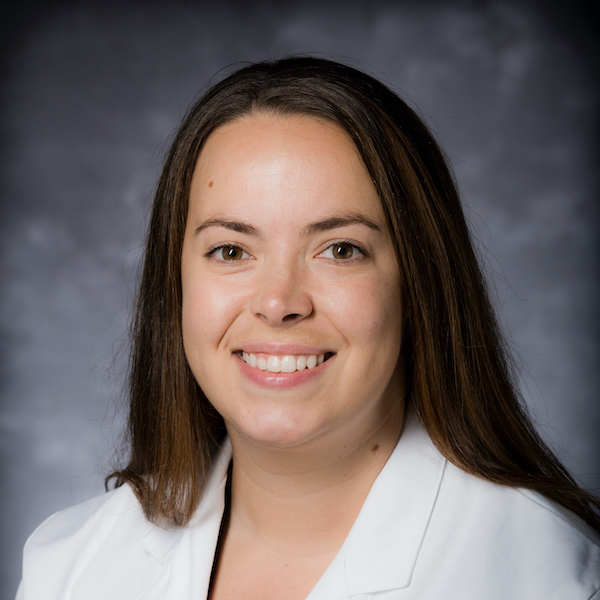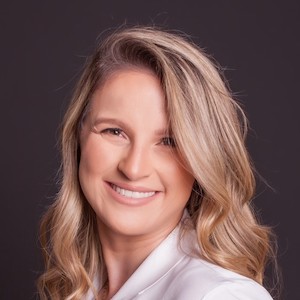




This year’s fully virtual meeting – December 9-12 – was a great success with fantastic reviews from IUGA members. The virtual platform and addition of IUGA Annual Meeting scholarships allowed many practitioners who are typically unable to afford attendance at a physical meeting to access the first-rate education and scientific content this meeting provided. This year we had 858 attendees, 342 accepted abstracts, and 8 workshops. We are pleased to provide a snapshot of the meeting with summaries of our main sessions in this issue of the IUGA Spotlight.
If the summaries provided in this issue inspire you to re-watch any of the sessions, your attendee link can still be used through June of this year to access the meeting sessions on-demand. If you missed the meeting entirely, you can purchase full on-demand access to the meeting content and view at your own leisure! Visit our meeting website to purchase your on-demand access today!
Thank you to the following volunteers for contributing summaries to this issue:




Opening Ceremony & State of the Art Lecture
A Peek into the Future of Surgical Learning: A King, an Ox, and Elon Musk
Moderators: Jorge Milhem Haddad, Dudley Robinson, Francis Seow-Choen
Presenter: Todd Ponsky
In a warm welcome ceremony, the IUGA President, Professor Haddad began by inviting all IUGA members to the 46th Annual meeting. While he regretted that we could not meet in person, given that one of the major goals of IUGA is to be inclusive, he was glad that the virtual platform allows unrestricted sharing of knowledge with colleagues across the world. He announced a new award, the IUGA Special Services Award, which was bestowed on Angie Rantell, Surendhra Ramphal and Jittima Manonai, this year. He also announced the Lifetime Achievement Award which was presented to Professor Robert Freeman who accepted it with a humble and inspiring address. This was followed by Dr. Roy Ng, the Chair of the local organizing committee, who shined light on the theme of the meeting, ‘Urogynecology Without Borders,’ and thanked every IUGA member who made the meeting possible. The IUGA Secretary, Dr. Dudley Robinson then extended his warm welcome to all IUGA members and expressed satisfaction about the increasing membership of IUGA. He introduced Todd Ponsky, who, in a memorable State of the Art Lecture, gave an interesting peak into the future of medical training. Given the exponential increase in medical knowledge, traditional models of disseminating information through journals, textbooks and societies are bound to prove inadequate in the future. He spoke of how we could use machine learning and AI and the power of the crowd to break through the clutter to arrive at the right source of medical information. He described a tantalizing future where the middlemen like publishing companies are eliminated and gave the example of a journal started by the Social Sciences Research Network to which anyone can submit an article and the crowd decides its worth. He elaborated on how the power of modern-day digital platforms and social media could be used to disseminate knowledge without barriers. His team spoke about their StayCurrent app which includes all information regarding pediatric surgery in one place, including articles, podcasts, infographics, guidelines. He elaborated on the game changing Storycast medical training idea which is a ‘choose your own adventure’ kind of video-based interactive learning session in which the audience decides the outcomes. Since medical media maybe a new career path, their group is now constituting a formal fellowship in medical media that will teach podcasting, video editing, marketing-interplay, content responsibility, social media, etc. He ended by discussing how digital platforms can even help in teaching surgery and gave examples of remote surgical telementoring and explored the role of artificial intelligence in telementoring.
Presidential Lecture
Moderator: Dudley Robinson
Presenter: Jorge Milhem Haddad
In a talk that reflected the spirit of collaboration exhibited by IUGA members during the pandemic, Dr. Haddad began by thanking the Program Committee, Local Organizing Committee, Scientific Committee, and Workshop Committee for organizing the virtual 2022 meeting despite the incredible challenges. He recognized the incredible role played by the IUGA Board, the IUGA Office, IUGA Committees, International Advisory Board, and FIUGA, in providing inspiring leadership during these trying times. He expounded on the vision and mission of IUGA, the strategic plan to ensure that the vision becomes a reality, and all the activities conducted by IUGA within the four pillars of the strategic plan in the past year, namely knowledge creation and synthesis, knowledge dissemination, organization strengthening, and advocacy. He reiterated that IUGA is the most relevant international organization worldwide. However, there is a western bias and hence his primary goal is to make IUGA truly global in scale and ensure that it addresses the concerns of all IUGA members from different cultures and regions. Dr. Haddad hoped that the IUGA guidelines for management of patients with urogynecological symptoms during the pandemic were beneficial to the members, including allied-health professionals. He also spoke of the wonderful academic work done by the Education Committee on IUGA Academy, the SIGs and the IUCs, the webinars and regional symposia conducted last year, the collaborations with AUGS, SGS and other societies, and the establishment of the Regional Advisory Boards. He finally thanked his family for their support.
State of the Art Lecture: MUS: Evident-based Medicine vs. the Medicolegal System
Moderators: Roy Ng, Kalaivani Ramalingam, Harry Vervest
Presenter: Charles Nager
In an enlightening and well-structured lecture, Dr. Charles W. Nager (USA) addressed the biggest conundrum facing modern urogynecology: the role of synthetic MUS in the field. He began by highlighting the fact that since its inception in 1997, the MUS have essentially replaced all other conventional procedures for SUI. He then walked us through the current evidence which supports the conclusion that in terms of efficacy, safety and adverse events, MUS are the best surgical procedure for SUI to date.
Dr. Nager then discussed the ban imposed by the FDA in 2019 on transvaginal mesh products used for prolapse because of increasing complications, which did not include MUS. This led to an enormous increase in litigation related to mesh implants in the United States. He then explained how due to increasing litigations, MUS fell prey to the “availability cascade” (a phenomenon whereby stories inform public perception and those challenging it are vilified), leading to changes in surgical practice worldwide with a ban or pause on MUS in some countries. He concluded by saying that we must acknowledge women who have been suffering from complications due to mesh procedures (mainly prolapse) but at the same time, not forget the majority of satisfied patients who remain silent and invisible. Otherwise, in this era of social media, evidence-based medicine may lose to the availability cascade, leading to the loss of the best surgical procedure ever developed for SUI.
Panel: OAB – A Syndrome of Different Aetiologies
Moderators: Peter Lim, Lisa Prodigalidad, Jan Paul Roovers
Speakers: Nazema Siddiqui, Lindsey Burnett, Marcus Drake, Andrea Tubaro, Takeya Kitta
Five distinguished Overactive Bladder (OAB) experts joined this excellent panel to discuss their work on the varying possible causes of this syndrome. Nazema Siddiqui (USA) reviewed current research on biomarkers that could potentially aid diagnosis in the future including proteomics, metabolomics, and others. Their role in diagnosis is still unclear but stay tuned as they could help target therapy in the future. Lindsey Burnett (USA) reviewed the difficult case of a patient with baseline urinary urgency symptoms in the setting of "asymptomatic bacteriuria.” Is this patient truly asymptomatic? Could the bacteria present be leading to her urinary symptoms? Could it be a cause of altered sensation in the bladder? She reviewed the most recent research involving the urinary microbiome and work with enhanced detection techniques. There is clear evidence that the urinary microbiome is different in women with OAB and controls. Marcus Drake (UK) then reviewed his work on “micromotions” demonstrated in both animal and human models that affect sensory nerve activity in the bladder. While present in normal bladders, this localized motion is more prominent in women with increased sensation. This phenomenon could explain why women may experience increased bladder sensation and urgency without demonstrable detrusor overactivity on urodynamics. Andrea Tubaro (Italy) reviewed the interesting association between metabolic syndrome and cardiovascular disease with OAB. His work has shown that metabolic syndrome and obesity alone are independent risk factors for OAB. He also reviewed interesting work involving a pathway in which vascular disease may lead to bladder ischemia and OAB. Finally, Takeya Kitta (Japan) reviewed the fascinating work that has been done by himself and others using functional brain imaging in OAB patients. Not only have both inadequate and exaggerated responses been observed in areas of the brain in patients with OAB but functional brain imaging may predict who may respond better to treatment. Functional brain imaging has also shown the neuroplasticity that occurs in regions of interest after medication, Botox, and sacral neuromodulation treatments.
Debates
Moderators: Linda Cardozo, Fred Miliani, Arthur Tseng
Vaginal Laser Therapy is the Best Treatment for Genitourinary Syndrome of Menopause (GSM)
PRO: Bobby Garcia
CON: Ann-Sophie Page
Bobby Garcia (USA) argued for the affirmative with valiant effort but graciously conceded early that vaginal estrogen should be the gold standard treatment for GSM. However, he made an argument that laser may offer a safe and effective option in certain cases (breast cancer, etc.) with convincing data. He concluded his argument emphasizing the importance of providing all available options to patients to guide their informed decision making.
Ann-Sophie Page (Belgium) argued the negative reviewing the mountains of evidence supporting use of vaginal estrogen for GSM. While agreeing that vaginal laser therapy appears to be safe, there is not enough evidence showing efficacy. Available data shows only minor differences when compared to sham treatment. Additionally, the current cost of laser therapy makes it inaccessible to most women.
Botox vs. Neuromodulation for Refractory OAB: Botox Must Always Come First
PRO: Anthony Visco
CON: Cheryl Iglesia
Anthony Visco (USA) argued for the affirmative citing improved overall continence with manageable side effects with intradetrusor Botox treatment. He also reviewed the literature that suggests Botox as a more cost-effective option when compared to sacral nerve stimulation.
Cheryl Iglesia (USA) argued the negative emphasizing that sacral nerve stimulation has a high satisfaction rate and can also treat urinary retention and fecal incontinence. Additionally, she argued that with the advances in MRI compatibility, longer battery life and rechargeable options, the cost effectiveness will improve.
Congratulations to all the debate participants who presented sound arguments all around!
Global Health Lecture: #DGH- Ruminations on the Role of Equity in the Decolonization of Global Health
Moderators: Grace Chen, Paul Tambyah, Ranee Thakar
Speaker: Lauri Romanzi
The aims and learning objectives of this session were to support a transformative discussion about how global health is engaged between high-income countries and low- and middle-income countries and to explore equity, reciprocity, and decolonization.
Resources needed for life-long learning and ethical, effective participation as an international clinician and public health practitioner were discussed alongside a commitment to using our skills and abilities to make this world a better place through ethics-based community-centered globalism. Dr. Erin Cavanaugh’s perspective that anyone can have the false perception that volunteering, and donating, can never be unethical, when, in fact, very frequently it can be, and it is, was discussed.
The take-home messages from this lecture were to invest in decolonization (department, division, committees, and working groups dedicated to all things equity), to look for enterprise partnerships across sectors (e.g., decolonization of economics, education, geopolitics), and to make equity, reciprocity, and decolonization highly visible across the organization’s structure.
Ulf Ulmsten Lecture: Childbirth and the Pelvic Floor: Where are we going?
Moderator: Jorge Milhem Haddad
Speaker: Robert Freeman
IUGA had the great honor of Robert Freeman (UK), distinguished Professor and past IUGA president, presenting the Ulf Ulmsten Lecture this year. His commitment to IUGA, and women around the world, inspires us all. He spoke to us about his passion for improving care for women especially during and after childbirth as it related to pelvic floor disorders. He proposed a framework and challenged IUGA members to work to make these issues a priority. This starts with engaging the obstetricians and midwives in discussions about these issues while acknowledging that their first priority is safe delivery of infant and maternal safety. Perhaps we, as urogynecologists, need to have more of a presence around the time of delivery. He then underscored the idea that optimal maternal safety should include limiting maternal morbidity including not only obstetric anal sphincter injuries, but also pelvic floor injuries that are not immediately apparent at the time of delivery and may cause symptoms later. He shared a patient’s story – in her own words – about the long lasting physical and psychological trauma that she experienced related to birth injury. He then shared the tools that can be used to prevent and treat these issues including decreasing use of forceps when possible, introducing preventative care bundles to obstetric units, and physiotherapy. He also encouraged members to check out the IUGA PROTECT Train the Trainers program. Likely the most important of all is education of not only providers, but also women, on the risks of vaginal delivery. He presented clear evidence that arming women with information about their individual risk for pelvic floor disorders is something that women want and would not necessarily increase the risk of request for cesarean section. In fact, his work has shown that women would be more likely to stick to physiotherapy if they knew their individual risk was higher! To finish, he challenged us all to do something quite logical: listen to the women!
Panel: Multidisciplinary Management of Mesh Complications
Moderators: William Han How Chuan, Rebecca Rogers, Steven Swift
Speakers: Ash Monga, Karen Guerrero, Thierry Vancaillie, Lucila Pavan, Howard Goldman, Chantale Dumoulin
The panel started with two interesting cases presented by Ash Monga (UK). Both cases were mesh complications due to transobturator tape. The first was a case of urethral perforation presenting as pain and voiding difficulty and the second patient presented with recurrent groin to thigh abscess due to infected TOT. The case presentations were followed by an informative lecture on the assessment of patients with mesh complications by Karen Guerrero (UK). She emphasized that a detailed clinical examination is the most important tool in the assessment of these patients. Thierry Vancaillie (Belgium) spoke on the management of mesh neuropathy and highlighted that surgery itself is a trigger for chronic pain, therefore treatment of patients with mesh neuropathy should be individualized, reserving surgical management only for women with acute neuropathic pain or cases not responding to medical management. Lucila Pavan (Argentina) presented her experience on partial versus total mesh excision in women with complications after transvaginal mesh for prolapse. She concluded by saying that mesh excision should only be done in symptomatic women and partial resection is associated with better outcomes and lesser complications as compared to total resection. Howard Goldman (USA), in his talk on sling-related complications, also emphasized that partial sling excision is often enough in most complications. In the final lecture, Chantale Dumoulin (Canada) presented a physiotherapist’s perspective on the management of mesh complications stressing the role of physiotherapy in focal and non-focal pain.
Allied health session - How I manage urinary urgency
Moderators: Hedwig Neels (Belgium), Angela Rantell (United Kingdom) & Maura Seleme (Brazil)
Panel
Speakers: Cristine Homsi Jorge Ferreira (Brazil), Sacha Newman (United Kingdom) & Dudley Robinson (United Kingdom)
At this session two clinal cases of urinary urgency were presented. Summarizing what was discussing the speakers emphasized the use of Bladder Diary, compartmental therapy, a good evaluation of symptoms, to pay attention on constipation, evaluate residual volume, diet, exercises, general quality of life. A detailed functional physical evaluation of the pelvic floor and learn about anatomy. Use of rapidly contraction to inhibit detrusor overactivity. Good water intake. In the case of pregnant woman with urinary urgency explain the importance of antenatal pelvic floor muscle exercise. Use of relaxation techniques. A good evaluation for the use of medications for OAB. Pay attention in the barriers for adherence. Some cases low doses of estrogens if indicated for pregnant and the use UR-CHOICE calculator. Discuss dry OAB and wet OAB and make a share decision of the way of deliver.
Panel: Allied Health Session: How I Manage Urinary Urgency
Moderators: Hedwig Neels, Angela Rantell, Maura Seleme
Speakers: Cristine Homsi Jorge Ferreira, Sacha Newman, Dudley Robinson
Two clinical cases of urinary urgency were presented. The speakers emphasized the following:
In the case of pregnant women with urinary urgency, the speakers said that it was important to explain the importance of antenatal pelvic floor muscle exercise and use of relaxation techniques. Thoroughly evaluate for the use of medications for OAB. Pay attention to the barriers for adherence. Low doses of estrogen may be indicated (use UR-CHOICE calculator). Dry OAB and wet OAB should be discussed, and shared decision-making should be employed in determining the best mode of delivery.
Panel: Management in the Elderly
Moderators: Manjula Annappa, Jason Lim, Adrian Wagg, François Herve, Jan Deprest, Chris Fox
Speakers: Anne Suskind, Adrian Wagg
Session moderators Manjula Annappa, Jason Lim, and Adrian Wagg, led a panel of experts as they presented their experiences, practices, latest evidence, and innovations in the management of various conditions in the elderly population.
Anne Suskind (USA) introduced an updated paradigm helpful in pre-operative risk assessment of the elderly, involving patients’ global healthcare goals, assessing the role of surgery in setting these goals, performing an assessment of frailty and cognitive impairment, and taking appropriate informed consent.
Adrian Wagg (Canada) gave an insightful talk on the increasing incidence of polypharmacy and its adverse effects in the elderly suffering from lower urinary tract symptoms (LUTS) and suggested how simple steps like reviewing all the medications and altering those that may aggravate LUTS can help in ameliorating this issue.
Following this, François Herve (Belgium) presented a multidisciplinary approach to the management of nocturia cases not responding to medical management and highlighted how managing comorbid conditions like obstructive sleep, varicose veins, and obesity can help reduce nocturia.
Jan Deprest (Belgium) discussed age-related surgical risk and how the frailty index can help in predicting serious complications in the elderly.
Chris Fox (UK) then concluded the session with his innovative talk on optimizing anticholinergic burden. He discussed the use of artificial intelligence-based computer programs to provide real-time updates on the anticholinergic effects as new data emerge and new drugs are introduced.
Basic Science Session: Personalized Medicine for Female Pelvic Floor Disorders
Moderators: Marianna Alperin, Jason Lim, Adrian Wagg
Speakers: Marianna Alperin, Kathleen Connell, Shayanti Mukherjee, Zeliha Guler
The Basic Science SIG conducted a very informative panel on personalized medicine for pelvic floor disorders. Kathleen Connell (USA) began by speaking of the need for a deeper dive into phenotyping-genotyping of pelvic floor disorders. She elaborated on the goals of personalized or precision medicine and the processes involved in developing precision-shaped treatments. She described how paracervical uterosacral biopsies are collected in her lab at the time of hysterectomy for prolapse and benign gynecological indications and subjected to both phenotyping (including trimchome immunohistochemical staining and the POP-Histologic Quantification tool developed by her lab), and genotyping (including matching of the uterosacral phenotypes in patients with POP [POP A, POP B and POP i] with control uterosacral ligament specimens, RNAseq-mRNA expression and the use of Illumina EPIC DNA methylation array for epigenome—wide analysis). She also spoke of their work in determining metabolic endotaxemia as a potential risk factor for POP.
Shayanti Mukherjee (Australia) elaborated on her lab’s work on 3D printing for pelvic reconstructive surgery and discussed the need for developing better meshes including nano-meshes that elicit a favorable foreign body response within the body. She spoke of their first proof of concept using a GESIM Bioscaffolder set-up to print both polymers and cells in a GMP facility. In the second step, they developed an alginate-aloe vera bio-ink which helped to increase M2 type of macrophages in their mouse model. She also described the use of the bio-ink as an injectable hydrogel in a rat model to reverse birth injury. Lastly, they also assessed the impact of angle of mesh design on foreign body response.
Zeliha Guler (The Netherlands) spoke about the importance of biomechanics in prolapse research including improved treatment strategies. She discussed the encouraging results of their study to develop non-invasive methods for biomechanical assessment of vaginal tissue in which they applied cutometry (a suction-based method which provides biomechanical outcomes like firmness and elasticity) and indentometry (which provides a penetration number representing tissue firmness) to the vaginal wall of 20 women with stage II or higher prolapse.